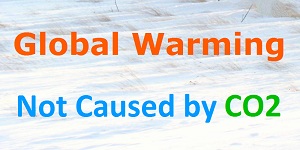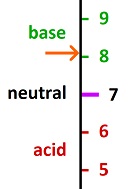|
| Gary Novak
The Cause of Ice Ages and Present Climate |
Oceans are alkaline at pH 8.1. This means there are less than one tenth as many hydrogen ions in the oceans as in neutral water. Oceans would need to be ten times as acidic to be neutral. This is because calcium carbonate is a strong buffer at pH 8.1. At that pH, water absorbs CO2, which is an acid being absorbed by an alkali. When oceans can hold no more CO2, they leave some in the atmosphere. As their temperatures increase, oceans release more CO2. Oceans constantly increase in temperature between ice ages causing a constant increase in CO2 in the atmosphere, until the next ice age occurs. Oceans absorb solar energy to a depth of 10 meters, which causes heat to accumulate. Also, geothermal heat enters the oceans and accumulates in a significant manner over time. It is only an ice age which allows oceans to cool back down. Ice ages occur every 100 thousand years. All Eukaryotic cells pump hydrogen ions (which create acid) across membranes to produce respiration and to control internal pH. This pump creates gradients of several pH units. To claim they cannot tolerate 0.1 pH change in their environment is unscientific.
Carbon dioxide propagandists have a campaign going for an "acid in the ocean" alternative to the greenhouse gas scare. This tactic is a result of the danger of the "greenhouse gas" lie blowing up in their faces at any time due to the obvious scientific frauds. Carbon dioxide has been an extremely effective and insidious propaganda scheme, being used as the latest pretext for population reduction and shoving the lower classes out of the economy. The public considers the greenhouse gas problem to be unquestionable science and an imminent peril. This does not immunize it from scientific truth, which is bound to expose it eventually. But the acid ploy is unrelated to global warming, and it salvages the propaganda value of carbon dioxide. The acid fraud says that humans are putting more carbon dioxide into the oceans (through the atmosphere), and the CO2 converts to acid in the oceans, while corals are supposedly sensitive to acid and cannot produce their calcium shells in such an environment. There has never been real damage to corals found as a result of increased acidity of the oceans. The damage to coral reefs which has been occurring is caused by heat, disease, etc., but not by acidity of the ocean water. There are major reasons why. Oceans have such a huge potential to neutralize acid that no significant pH change is occurring. The human production of CO2 per year is 0.014% of the amount of carbon already in the oceans. Part of the carbon which enters the oceans is converted into neutral cell mass; and this is one of the reasons why there is no acid problem. Biology converts CO2 into neutral cell mass. Another reason why the acid scare is a fraud is because the CO2 levels in the atmosphere always fluctuate during ice age cycles, and the cycle is exactly the same now as it was during the previous ice age. There is nothing unusual about it. Biology easily adapts to such variations. Physiology totally controls pH within cells. This means that the pH of ocean water has no relationship to the pH within the cells, where calcium carbonate shells are created. Survival of ancient coral reefs is a different matter, but creating them through living cells is a not a pH problem in the oceans. pH will affect the algae which are exploited by corals, but as one species leaves, another species which is more adapted to lower pH enters. One of the most difficult questions to study in biology is how cells control their internal pH. It's difficult to study, because every chemical reaction in a cell influences pH. Evolution takes into account the total effects and produces a result which is favorable to survival. As a result, acid comes and goes in biological cells with no indication of where from or where to. All biologists can do is observe the end result. And biologists observe total control over extremes in pH in biological systems. Propagandists claim carbon dioxide is an acid, and acid destroys carbonate in the ocean, while corals require carbonate. But CO2 isn't just an acid; it is in equilibrium with carbonate. This means more CO2 entering the oceans results in more carbonate, not less. There are two scientific frauds involved. One is to view CO2 only as an acid, as if it were equivalent to hydrochloric acid, while ignoring its equilibrium with carbonate. The other fraud is to ignore the huge buffering capacity of the oceans, which results in no detectable acidity from CO2 entering the oceans. When adding up the absence of increased acidity with the equilibrium between CO2 and carbonate, the net result is that CO2 is increasing the carbonate which corals need, not decreasing it. A new study and web site explains the oceanography of carbon dioxide and shows the errors of the propagandists who claim that increased CO2 in the oceans will make the oceans more acidic and destroy coral reefs. Near the surface of the oceans, increased photosynthesis creates alkalinity rather than acidity. There is in fact a shortage of acid near the surface for the promotion of photosynthesis. The decay which creates acidity occurs 1-2 kilometers down, which is way below the level of coral reefs. This subject is explained by Dr. J. Floor Anthoni here: Another Study: Science Magazine, April 18, 2008 Iglesias-Rodriguez, et al, Phytoplankton Calcification in a High-CO2 World. April 18, 2008. Science 320: 336-340.
http://www.sb-roscoff.fr/Phyto/index. Dr J Floor Anthoni describes the study as follows: An important and complicated study looked at the plankton record in a deep sea core of the North Atlantic while also conducting experiments with living cultures of one of the most common small phytoplankton organisms, the coccolith Emiliania huxleyi. This coccolith is a major contributor to calcium deposits in the oceans (50%). Contrary to other studies that found a decrease in calcification, this study found an increase in calcification, accompanied by larger individuals, although at somewhat slower growth rates. The difference in experimental setup may have been decisive: whereas others changed the pH by adding external acids or bases, this team mimicked the real world more accurately by bubbling air with known concentrations of CO2 (280-750ppm, pH=8.1-7.7) through their cultures. This gives high credibility to their findings:
The curve has a hockey-stick appearance, climbing more steeply in the past 25 years (~25%). This study shows that paradoxically, even though calcite dissolves more rapidly at higher carbon dioxide concentrations, it is apparently also more easily made, resulting in heavier shells. A lower pH also encourages productivity, which provides the energy to grow bigger and to make larger shells. Note that this is exactly what we predicted earlier. The deep sea cores furthermore show that coccoliths provide a substantial sink for CO2, while adjusting to high-CO2 conditions by increasing this sink. Please note that studies like this and others need to be replicated and confirmed, and also note that the carbon chemistry of the oceans interacts with stabilising sediments (buffer). Also note that sea temperature plays an important role. Dr J Floor Anthoni CO2 and Coral Reefs - A review of the science by SPPI
|
||||||||||||||||||


 No one has ever found any other pH in the oceans than pH 8.1 apart from sheltered estuaries, related effluent, micro environments and melting ice.
No one has ever found any other pH in the oceans than pH 8.1 apart from sheltered estuaries, related effluent, micro environments and melting ice.